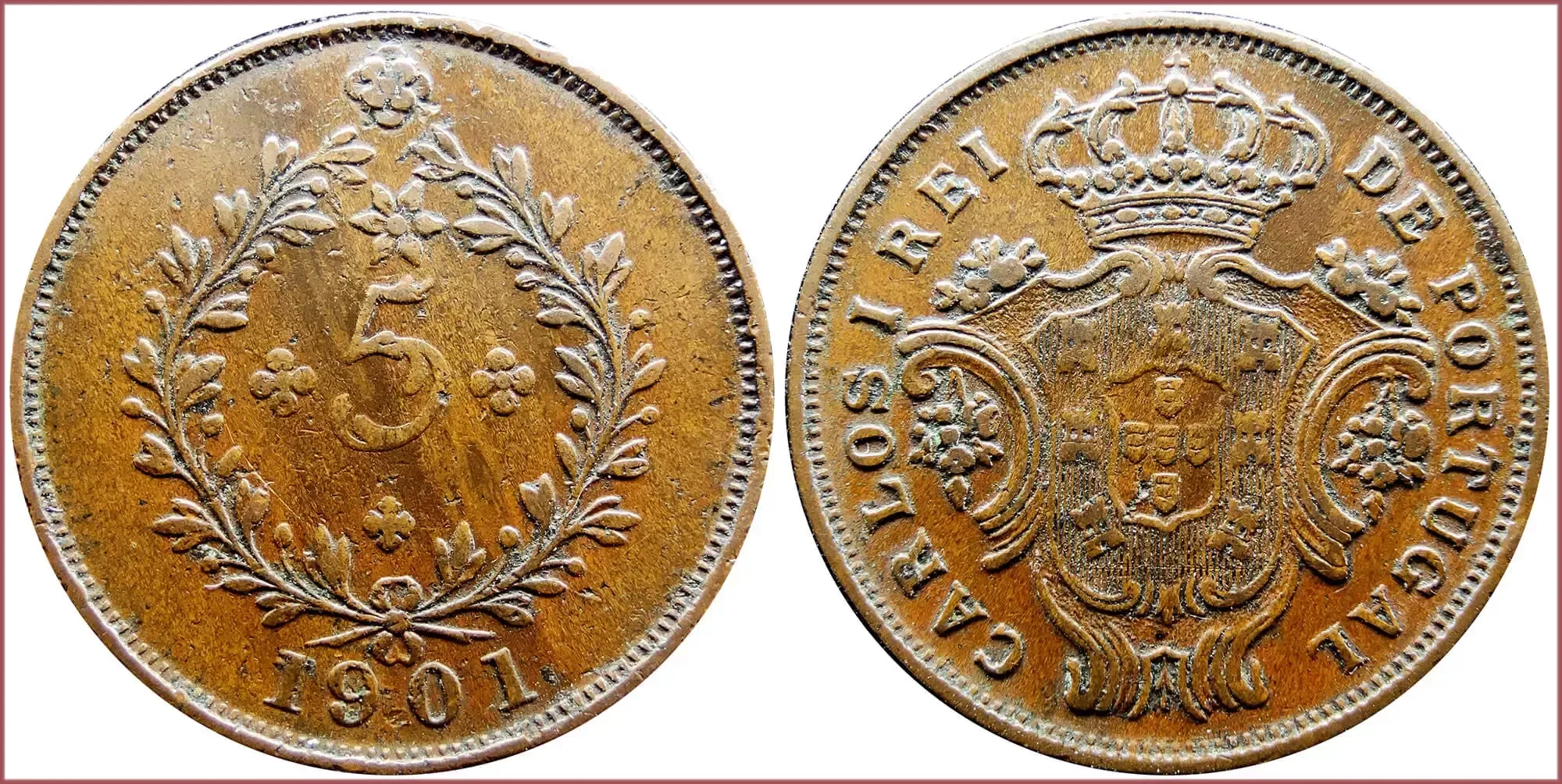REAL: COIN OF AZORES
5 réis, 1901: Azores (Portuguese administration)
Ruler: Carlos I of Portugal — King of Portugal from 1889 until his assassination in 1908; he was the first Portuguese king to die a violent death since King Sebastian in 1578.
5: the value of the coin is displayed exclusively in the format of numerical notation only — without indicating the name of the denomination.
CARLOS I REI DE PORTUGAL: Carlos I — King of Portugal.
Small royal coat of arms of Portugal on decorative crowned shield.
Mintage: 800.000.
- Copper: 25 mm - 4.72 g
- Reference price: 18$
COIN REAL — WHERE & WHEN (coins catalog: by names & emitents)
Just like the centavo this coin is characteristic only to Spanish-speaking and Portuguese-speaking countries (Spain, Portugal and their colonial possessions).
The real coin has been issued since the 14th century by a number of states:
- SPAIN, ARGENTINA, BOLIVIA, CHILE, COLOMBIA, COSTA RICA, DOMINICAN REPUBLIC, ECUADOR, GUATEMALA, HONDURAS, MEXICO, NICARAGUA, PARAGUAY, PERU, PHILIPPINES, VENEZUELA...
- PORTUGAL, ANGOLA, AZORES, BRAZIL, CAPE VERDE (only banknotes), GUINEA-BISSAU (only banknotes), MADEIRA, MOZAMBIQUE, SÃO TOMÉ AND PRÍNCIPE...
REAL as coin name.
Real (plural: réis, later — reais) is monetary unit of Brazil during 1690-1942 and from 1994 to the present day. The modern Brazilian real is divided into 100 centavos and is currently the only valid currency of this denomination in the world.
Historically real — old coin of Spain and Portugal, as well as their colonies in Asia, Africa, and America.
The first real appeared on the Iberian Peninsula: in Spain in the middle of the 14th century, in Portugal — a few decades later.
During 1850-1864, the real acted as the main monetary unit of Spain, while previously it was 1/16th of the escudo. It existed until 1864, when was replaced by a new escudo.
Real until the end of the 19th century was used as an escudo or peso exchange coin in the following Spanish colonies in Asia and America: Philippines, Argentina, Bolivia, Venezuela, Guatemala, Honduras, Dominican Republic, Ecuador, Colombia, Costa Rica, Mexico, Nicaragua, Paraguay, Peru, Chile.
The Portuguese real was also minted for about half a millennium — until 1911 (before the overthrow of the monarchy and the establishment of a republican form of government), when it was replaced by the Portuguese escudo. At first it was equal to 1/6400 peça, and since 1826 it has become equivalent to 1/7500 peça. Modern Portuguese autonomous regions also until the beginning of the 20th century used their own real coins in circulation: Azores until 1901, Madeira until 1852.
Portugal's colonies on the African continent also actively used real in their monetary circulation — their own regional varieties of coins and banknotes. For a long time, before the introduction of the escudo in 1914, the real circulated in Angola, Guinea-Bissau (at that time — Portuguese Guinea: only banknotes), Cape Verde (similarly — exclusively banknotes), Mozambique (until the middle of the 19th century), Sao Tome and Principe (until the beginning of the 19th century).
The name of the coin real translated from Latin means "royal" — "regalis". It was customary to use the term "milréis" to denote a thousand reais (in Spanish and Portuguese, "mil" just means a thousand). In Portugal, the name milréis gained almost more popularity than real.

